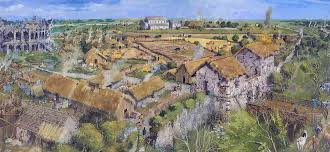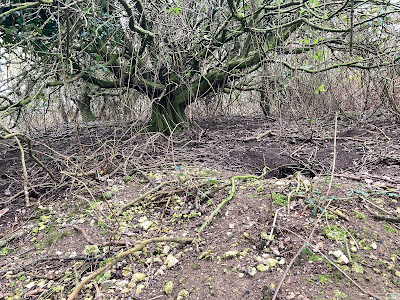The effects of the Roman withdrawal from Britain in 410CE and of the arrival of Germanic peoples a few decades later have long been debated.
Did the economy and the rule of law collapse or did remaining Romano-Britons continue much as before?
Did the Saxons (and Angles and Jutes) arrive as warriors, clearing out the Britons towards the west and north and taking over their lands to be settled by their kinfolk, or did the new arrivals assimilate with the native population (albeit in a dominant role). Were the remaining Britons enslaved?
Canterbury Museum has an excellent series of model tableaux indicating the grandeur of the city under Roman occupation with forum, amphitheatre, theatre and so on, and of that city in ruins some time later.
Bede describes a genocide and was influential for many centuries, while others (more recently) have argued for more integration.
Alan Everitt in Continuity and Colonization Evolution of Kentish Settlement uses locations and place-names to try to tease out an answer (Lambarde in the late c16 also used his interest in Anglo-Saxon language to seek evidence) but there is clearly a need for new methods of investigation.
A KCC paper in 2013 recommended such a fresh approach to the Romano-British/Anglo-Saxon transition, and a project which concluded with The Fields of Britannia by Stephen Rippon analyses a different set of data, using "a regional approach to studying landscape", using:
- pollen samples
- field systems and
- landscape development.
Pollen data is analysed by region, to provide changes in the proportion of plant types in the landscape during and just after the Roman occupation. An increase in tree pollen and a reduction of pasture and arable plant pollen would indicate a loss of farming activity:
For the south east region (admittedly a large and varied area) there was indeed a change in this direction, with the greatest change of all the regions:
Woodland pollen increased by 5-6%, and unimproved pasture pollen by 3-8%, whereas arable pollen fell by 1-2% and improved pasture pollens by 8-11%. This could support a theory of discontinuity but as the author points out this could just reflect the reduced need for supplies for the Roman empire.
Animal bones and crop residues give more clues to agrarian changes; beef gave way to sheep and goats, and wheat was eclipsed by barley, rye and oats, reducing the trade in goods most needed by the Roman market-based economy in favour of local self-sufficiency.
Landscape development
In a very difficult area of study, the project concludes that 50-60% of pre-Saxon field patterns remain visible today, and that since woodland regenerates to a level that obscures previous boundaries within 30 or so years (questionable?) that - and the pollen evidence summarised above - supports the view that there was not a significant abandonment of agriculture after the Roman withdrawal, but a reduction in its efficiency and yield.
However, the issue of population should be considered; the estimate for England is 4m during the Roman occupation based on the amount of land used, but only c1.5-2.2m at the time of Domesday, a significant fall. A number of points arise from this comparison:
- is the method of estimate appropriate?
- if so, is the fall due to mercantile and urban population loss, leaving the countryside at a similar level;
- was there a significant reduction in food production efficiency (in line with lower demand) but similar settlement sizes for this reduction?
- was there only a small number of Germanic invaders (conquerors not settlers) who drove the unproductive (urban) population to the west?
Conclusions of the project
The overall conclusion of The Fields of Britannia project is that the money-based market economy did indeed collapse leading to more subsistence-based agriculture, while higher-status (and effectively less economically-useful) parts of the population would have been most affected. Towns and villas became unimportant and so were depopulated.
This principle is continued by Fiona Fleming who analysed settlements in north Kent during and after the Roman withdrawal and found relatively little continuity, with even lower status settlements persisting in only 20% of cases studied.
The Saxon migrants settled (at first at least) in the most favoured areas, not where the Romano-British had been based. In Kent, lands near the north and east coast and rivers were easily accessible, defendable and productive, so early settlements near Eastry, Mongeham, Thanet, the Medway and the Darenth were quickly populated.
Applying this conclusion to our local area
Landscape development is a tantilising subject for local field-walkers, who (if you're like me) "see to much". It is especially interesting when you have a Roman road system on your doorstep, and so try to apply local structures like field boundaries, chapels and churches, villages and water courses to the road.
As Paul Harvey and John Blair observe in the context of local historical studies, a map is the best possible antidote to scholars’ often subconscious tendency to focus on what is there to be studied, and to airbrush out the gaps in knowledge: "The map will have none of this. It gives equal emphasis to every part of the whole and there can be no sliding over doubtful points. … Faced with the questions posed by any reconstruction on a map one realizes just how imprecise one’s knowledge is, how many gaps there are that on the map will have to be represented by blank spaces or the most hesitant of outlines."
Two local sites illustrate this theme, one from Romano-British time and one after the withdrawal.
Beside the Roman road running north from Dover towards Richborough there is a very clear settlement outlined by cropmarks (the 2007 aerial photography is particularly good), which A.E. Johnson who investigated this area and published papers in 1999 and 2000, concluded represent "a series of conjoined and relatively well organised enclosures of probable later prehistoric or Romano-British date". There appears to be no evidence of later use, despite the close proximity of the road which remains in use up to modern times.
In contrast, apparently from later date, between Ripple and Mongeham on Beacon Hill there are crop marks showing the locations of an early chapel (left, below) and a large burial ground (right) which seem to be early Saxon.


These are well away from the current village of Great Mongeham with its church dated from Norman times, although incorporated into its fabric are many pieces of Roman brick; was there a Christian church on the current site when the Saxons arrived, and they relocated the cemetery to Beacon Hill, and then moved back to the village on reconversion?
There needs to be an archaeological study on the Beacon Hill site to determine the dates of occupation (was it occupied before Saxon times?)
Excavation of a cemetery north of Sangrado's Wood (Updown, near Eastry) found 77 graves with at least 20 encircling ditches, dating from the second half of the 7th century and possibly associated with the royal villa at Eastry. Grave goods were absent or modest but included spears, knives, beads, latch lifters, shears, bangles, pins etc plus pottery and glass vessels - on the cusp of conversion to Christianity?
John Blair in The British Culture of Anglo-Saxon Settlement writes
"Kent is one of the unlikeliest places to be considered marginal in a conventional view of Anglo-Saxon England. Why, with such spectacularly rich cemeteries and minsters, such an abundance of metal small-finds, and the opulent sixth- to seventh-century aristocratic culture now displayed at Lyminge, is ordinary rural settlement so elusive? A continuing British — and thus invisible — domestic tradition is perhaps not quite so implausible as it might seem, given the unusually persuasive hints of a British ecclesiastical tradition in late sixth-century Kent."
Eastry's settlement is especially elusive.

































